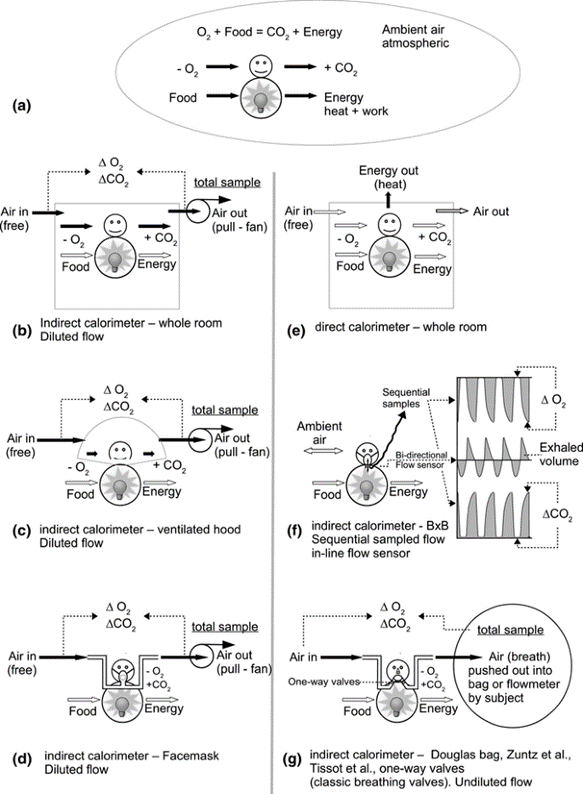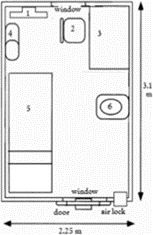Schoffelen & Plasqui explained the different types of open-circuit indirect calorimetry solutions in their 2017 paper: “Classical experiments in whole-body metabolism: open-circuit respirometry—diluted flow chamber, hood, or facemask systems”.
Introduction
Theoretically, there are several basic types of indirect calorimeters to choose from, each of which may be distinguished by the linkages between the subjects and the techniques applied to gather and assess air. During activity and occasionally while at rest, a fixed connection to the face is used (Fig. 4d, f, g). For this, a mouthpiece with a nose clip or a facemask (Fig. 4d, f) can be utilized (Fig. 4g). In this text, the term “facemask” refers to the prospective usage of a mouthpiece unless otherwise specified. With a facemask, there are three different ways to collect exhaled air: (1) full capture of exhaled breath that hasn’t been diluted (Fig. 4g); (2) full capture of exhaled breath that’s been diluted in a bypass flow; or (3) breath-by-breath (BxB) analysis for a partial sample of exhaled breath (Fig. 4f). Typically, basal (or resting) metabolic rate is measured using a ventilated hood device (Fig. 4c). A small, enclosed chamber is made by placing a clear plastic hood over the subject’s head to completely absorb exhaled air that has been diluted by a bypass flow drawn through the hood. To measure EE over longer periods of time, a whole-room calorimeter, sometimes referred to as a respiration chamber, is utilized (Fig. 4b). Here, a large volume of bypass flow and complete absorption and dilution of exhaled air are present (room). To completely capture exhaled air in a diluted flow, respiration chambers, ventilated hoods, and facemasks can all be utilized (Fig. 4b–d).

Fig. 4
An illustration of calorimetry showing how food is progressively burned by humans while they breathe oxygen to produce energy and CO2. The following two graphs show whole-room indirect calorimetry (b) and direct calorimetry (e), with the associated measured parameters indicated by black arrows. The indirect calorimeter (b) is dragged as a pull mechanism, drawing air through the space. This is almost equivalent to the conventional setup for a lesser volume ventilated hood system (c) and can also be used with a facemask linked to an airflow without a flow sensor (f) or breathing valves (h). Types b, c, d, and e of the calorimeters allow for free breathing with forced ventilation (pull fan), which over time dilutes the breathing in a larger volume (flow). The other two (f, g) demonstrate, respectively, how to transport sequential samples of inhalation and exhalation using a single sample line and an in-line bi-directional flow sensor (f breath by breath or BB) and how to do so using conventional one-way breathing valves to aggregate total exhalation in a Douglas bag or totaling flowmeter (g). The latter two function by drawing all airflow from the subject’s respiration.
With the theoretical exception of breath-by-breath devices, the bulk of indirect calorimeters will measure over a longer “aggregate” interval, i.e., spanning multiple breaths. Because full collection of exhaled air is typical, it is unnecessary to make any assumptions about the timing of breathing and gas analysis. This can be viewed as a positive because synchronization is challenging to establish or prove, especially with the greater respiratory frequency. The measurement of multiple breaths over an aggregate interval in a small volume may have an inaccuracy of 0.5 breathes unless breathing is evaluated for synchronization. As a result, slow breathing rates during rest may result in perceptible EE peaks and troughs.
Due to breathing’s variable tidal volume, even breath-by-breath measurements will reveal variation. As a result, multiple breaths taken over an aggregate interval are required. Because individual breaths average out in the larger volume, breathing is believed to have little impact on larger volume (room) calorimeters.
Principle of diluted flow calorimeters with open circuits
Indirect calorimeters using open-circuit diluted flow respirometry are essentially the same as other open-circuit respirometry applications, with the exception of measuring diluted breathing in a larger volume as opposed to measuring undiluted subject exhalation using a mixing chamber, Douglas bag, or by taking undiluted breath samples at the mouth (breath-by-breath systems).
The most well-known open-circuit diluted flow calorimeters are the majority of whole-room calorimeters or respiration chambers, whereas the majority of ventilated hood applications. Fresh air is always continuously pushed into the chamber, hood, or facemask while measuring the flow through the equipment and analyzing the O2 and CO2 contents in the air (Fig. 4a–c).
A respiratory chamber keeps the individual cozy and obstruction-free while engaging in activities or sleeping while monitoring EE during prolonged stay durations. Contrarily, the less comfortable facemask enables the measurement of EE over periods as brief as a useful 30 s. A ventilated hood enables for bedside application while providing the absolute minimum of comfort required for BMR measurement, falling between between a facemask and an entire room.
One essential feature that distinguishes these calorimeters from others is the volume in which exhaled air is captured. Compared to a room’s volume of 5000 to 30,000 liters and an average air flow rate of 100 liters per minute, a vented hood system has a volume of around 25 to 40 liters and an average air flow rate of 60 to 100 liters per minute for adults of average weight. The airflow past a facemask can range from under 100 liters per minute for resting or moderate activity EE to over 500 liters per minute for testing at maximum exertion when using one. The mask’s capacity is quite small (VO2max). Flow, volume, or volume over time, is a key factor for calculating EE with indirect calorimeters. It should be stressed that variables like temperature, pressure, and usually humidity level affect any volumetric statement. The well-known denominators for ambient, body, and standard temperature and pressure are, respectively, ATP, BTP, and STP. These are supported by relating water vapour concentrations that are saturated (S) or dry (D) (no S or D indicates an unspecified percentage of water vapour, possibly measured). As a result, BTPS is a saturated “wet” volume at 37 °C body temperature and the typical ambient pressure while STPD is a dry volume at standard conditions of 0 °C and 1013.25 mBar (measured). Given their large differences, these volumetric metrics must be precisely described and quantified. Diluted flow calorimeters normally convert all volumetric values to STPD notation, although non-diluted flow calorimeters may use an ATPS assumption for Ve, i.e., expired “wet” air at 37 °C.
Another component of volume is dead space. The open passage between the subject’s mouth and the fresh air volume or flow is created by the absence of breathing valves or in-line flowmeters in open-circuit diluted flow indirect calorimetry, which enables a larger stream of air to pass the patient. An artificial channel and/or resistance synchronized with the subject’s respiratory flow may have an effect on the subject’s performance. The volume of the small route or “dead space” artificially lengthens the anatomical dead space, or the section of the airway not actually involved in breathing, which reduces alveolar ventilation (the active ventilation of the lung).
The combination of any artificial flow resistance and the anatomical airway resistance will increase the effort required to breathe. Reduce breathing resistance and dead space as much as possible when measuring EE with indirect calorimetry. This is because some components of dead space and resistance can be reduced, or virtually totally removed, by eliminating flowmeters or breathing valves that are directly in line with the subject’s breathing.
For open-circuit diluted flow indirect calorimetry, Figure 4 depicts three different calorimeter types (Fig. 4a–c). Additionally featured are a standard non-diluted calorimeter using breathing valves and a flowmeter (Zuntz and Schumburg 1901a; Tissot 1904) as well as a direct whole-room calorimeter (Fig. 4e), an indirect breath-by-breath calorimeter (Fig. 4f), and a breath-by-breath calorimeter. An illustration of a closed-circuit calorimeter is absent. Fig. 4b illustrates how the first indirect room calorimeters gathered all exhaled breath and analyzed its chemical composition historically. This most closely resembles Lavoisier’s original design for capturing all exhalation in a non-diluted flow (Fig. 4g).
Whole-room calorimeters
Human EE is measured in a respiration chamber over an extended length of time, often between 12 and 36 hours (night-day), and up to several days (for example, overnight to measure sleeping metabolic rate). A chamber has several advantages over a ventilated hood or facemask, including the ability to measure 24-hour energy expenditure (EE) and capture all of its various components, including diet-induced thermogenesis (DIT), sleeping metabolic rate (SMR), basal metabolic rate (BMR), and activity-related energy expenditure (ARE) (AEE). The latter is not typical of everyday AEE and is obviously confined by the small chamber. To more precisely simulate real-world settings in terms of overall EE, an activity protocol can be used (e.g., by adding a bicycle to the room). A respiration chamber typically has a bed, table, chair, sink, TV, airlocks and sample ports, intercom, phone, and computer (Fig. 5 ). For privacy reasons, windows should have curtains, and any cameras should have an off button.

Fig. 5
Schematic of a room-calorimeter setup in the Metabolic Research Unit Maastricht, The Netherlands.
Related products
Whole body room calorimeters
The Room Calorimeter offers the highest validated accuracy and reproducibility in the market. Designed on a system level out of the highest quality components, this is the gold standard for energy expenditure studies of any kind; 24-hr energy expenditure, high intensity exercise testing and many more. Validated and applied in 100’s of research studies.
How can we help you with your research?
Maastricht Instruments creates equipment in the field for indirect calorimetry measurements. We provide support for studies, research and measurements alongside our indirect calorimetry products.
Consult us about our indirect calorimetry metabolic cart, whole room calorimeter systems or accelerometry add-ons. Please contact us or find more information on our information pages.
Reference
Schoffelen, P.F.M., Plasqui, G. Classical experiments in whole-body metabolism: open-circuit respirometry—diluted flow chamber, hood, or facemask systems. Eur J Appl Physiol 118, 33–49 (2018). https://doi.org/10.1007/s00421-017-3735-5
